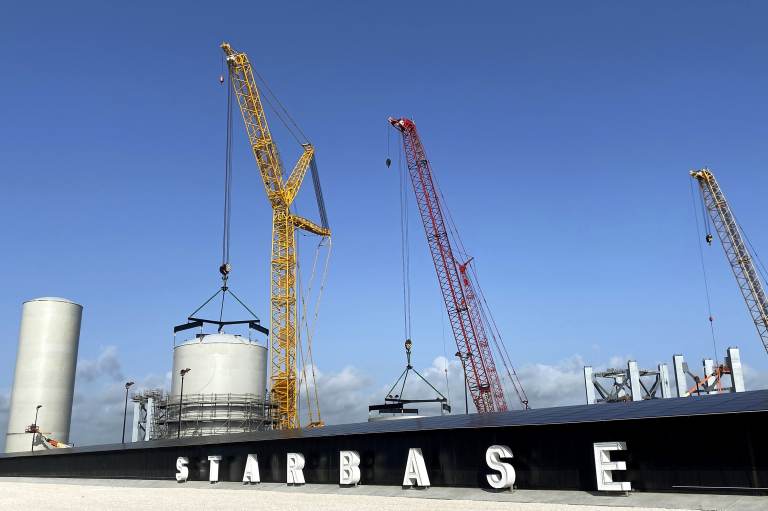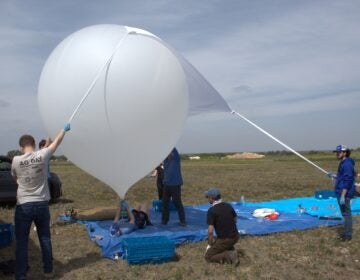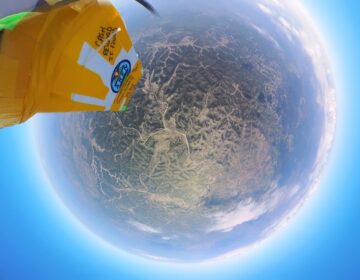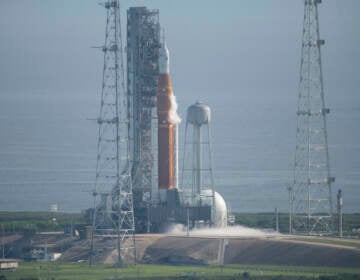SpaceX’s new rocket factory is making its Texas neighbors mad

Elon Musk has named his expanding rocket factory and launch complex in South Texas "Starbase," and expects it to grow by several thousand more workers. (John Burnett/NPR)
What Elon Musk has built on the remote mudflats at the southern tip of Texas is astonishing: gantries, fuel storage tanks, an Airstream trailer village, and a silver rocket straight out of Buck Rogers—all fronted by neon letters that spell out “Starbase.”
But can SpaceX coexist with the original feathered inhabitants on the lower Gulf coast? Environmentalists from Brownsville to Washington D.C. are protesting his ambitious vision to build, test and launch next-generation rockets in this fragile ecosystem.
“It’s 24/7. The lights are really bright out here at night. It’s just constant sound and presence of people,” says Stephanie Bilodeau, a conservation bird biologist with the non-profit Coastal Bend Bays and Estuaries Program. “I wouldn’t want to be nesting near any of this if I were a bird.”

John Burnett/NPR
She comes out with her spotting scope four times a week to look for plovers and red knots. And she says since SpaceX moved in, these migratory shorebirds that cross the continent to nest here have all but disappeared.
“It doesn’t look like much, these vast mudflats,” she says, scanning the expanse of sand, slick with black algae, “but it’s insanely important for shorebirds. The best habitat is right here along Highway 4. And the more expansion there is, the less likely they’re going to be able to nest in the areas that they want to nest.”
Less than 100 yards behind her, a massive heavy-lift crane is preparing the site for the next test launch. When Musk broke ground here in 2014, the fact that he was sandwiched between the Lower Rio Grande National Wildlife Refuge and a small colony of sunburned retirees didn’t cause alarm.
Now it does.
His original plans were to test and launch the slimmer Falcon 9 rocket a dozen times a year to loft satellites into orbit. But his plans have expanded—not surprising for the hard-charging Musk, who also owns the electric car company, Tesla. Today, he’s using this limited acreage to build and test his Super Heavy-Starship prototype. In April, NASA awarded SpaceX a $2.9 billion contract to build a Starship to take astronauts to the moon, though the contract has since been suspended.
But experimental rockets mean things blow up, and that’s what happened during a test flight on March 30.
“As you can see from the frozen camera view we lost the clock at T-plus 5 minutes, 49 seconds. Looks like we’ve had another exciting test of Starship number 11,” the launch commentator said, optimistically. (On May 5, another Starship prototype reached a height of 6.2 miles and returned for a safe landing on a concrete pad. Later this summer, SpaceX plans to launch another unmanned Starship into earth orbit for the first time.) The March 30 explosion showered debris for five miles, including onto the wildlife refuge which is classified as critical habitat.
“These rockets, these ships are more massive and create that much more thrust than the rockets that were originally proposed to be launched there,” says David Newstead, director of the coastal bird program for the Coastal Bend Bays and Estuaries Program.
But what most chaps locals is that SpaceX has been closing off access to popular Boca Chica Beach much more frequently than the company originally proposed. Earlier this month, the local district attorney threatened legal action against SpaceX for unauthorized road closures and for its private security officers exceeding their authority.
SpaceX activities are overseen by the FAA—which declined comment—and Cameron County in Texas. The top elected official there, County Judge Eddie Treviño Jr., says they both should be more vigilant of the private space company.
“We probably weren’t doing what we should have been, so I understand (the public’s) concern and we’re trying to do a better job going forward,” Treviño says. “By the same token, we need them and want them to succeed.”
Starbase employs nearly 1,700 people with a payroll of over $80 million. For a historically poor county where the best and brightest often felt they had to leave the Rio Grande Valley, SpaceX has been a godsend. Musk—believed to be the world’s richest person—has been generous when the moment called for it. Within minutes of the Starship 11 explosion—with rocket parts still smoldering on the landscape—he tweeted that he was donating $30 million to Cameron County and the City of Brownsville for schools and downtown revitalization.
Tony Martinez was mayor of Brownsville when Musk chose South Texas for his launch complex over Georgia, Florida, and Puerto Rico
“He (Musk) told me, ‘Mr. Mayor, one day you’re going to read in the history books that a man left Brownsville and went to Mars,’ ” Martinez says. “Anytime you have progress, there’s nothing that doesn’t come with some downside.”
Musk is turning Starbase into his company town. He continues to buy up private plots tucked amid the mudflats, he expects the launch compound to grow by several thousand more workers, and he recently asked for his own post office.
In March, SpaceX applied to the U.S. Army Corps of Engineers—which oversees the nation’s wetlands—for permission to fill in 17 acres of wetland to expand its launch facility. The major addition would include an expanded solar farm, parking lots, a new launching pad, a desalination plant and a power plant.
The EPA and the U.S. Fish & Wildlife Service along with national conservation groups such as the American Bird Conservancy are opposed to the expansion plans in their current form, saying it is incompatible with the wildlife refuge.
SpaceX, headquartered in Hawthorne, Calif., did not respond to a request for comment.
Aerospace facilities can coexist with fragile environments. Kennedy Space Center in Florida is inside the boundaries of Merritt Island National Wildlife Refuge and Canaveral National Seashore, which were created after the launch center’s founding in 1962.
“For over 50 years, we’ve had a partnership with both the refuge and the seashore as we grew and operated the space port, and we all carried on our missions,” says Don Dankert, with the Environmental Management Branch at KSC. “We have a longstanding history and I think we’ve done an exceptional job.”
He says as part of their ecological monitoring program, the launch complex turns off lights during sea turtle nesting season and has relocated gopher tortoise burrows in the path of construction. Recently, the Florida Sierra Club urged the space center to closely monitor water quality in neighboring Indian River Lagoon as KSC expands its footprint to make room for more commercial space activity. A KSC spokesperson says they are fully committed to “minimizing impacts to the natural and built environment.”
Few believe that pushback from environmentalists will slow down Elon Musk.
“He is used to getting his way. He didn’t get his way in California so he just left,” says Jim Chapman, with Save RGV in the Rio Grande Valley. “So now he wants to get his way here and so far nobody is really calling him on it.”
Most of those retirees who lived next to SpaceX in Boca Chica Village have sold out and moved away, though a handful of unhappy holdouts remains.
Then there’s Homer Pompa, a 71-year-old Vietnam vet, psychedelic blues singer and hermit who lives three miles away in a trailer with an assortment of cats, dogs and goats.
“Welcome to heaven,” he says from atop his three-story prayer tower/observation deck. His lookout has a commanding view of SpaceX on one side, with the rippling Rio Grande and Mexican prairies on the other side. Pompa says he and his friends have made peace with his aerospace neighbors.
“I got badger friends, rattlesnake friends, skunk friends, possum friends. I got a lotta friends out here, man.”
Have the rocket tests chased away any of his friends?
“No, they ain’t scarin’ (expletive),” he replies with a grin.
Nevertheless, the FAA has told SpaceX it needs to draw up a new Environmental Assessment as part of its license application to launch the Starship.
9(MDAzMzI1ODY3MDEyMzkzOTE3NjIxNDg3MQ001))




